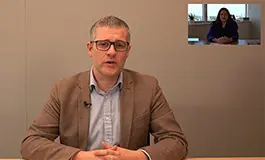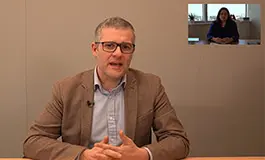Non–Small Cell Lung Cancer
Lung cancer is classified by histology into small cell lung cancer (SCLC) and non–small cell lung cancer (NSCLC).1 NSCLC accounts for 80% of all lung cancer cases. Subtypes of NSCLC are characterized by progenitor cell and include squamous cell carcinoma, adenocarcinoma, adenosquamous carcinoma, and large cell carcinomas.1 Common genetic alterations in NSCLC include EGFR, KRAS, BRAF, ALK, and ROS1.1
Incidence in the United States
Lung cancer is the leading cause of cancer-related deaths in the United States, with 127,070 deaths estimated in 2023.2 During the period of 2015-2019, incidence was 27% higher among men than women.2 It was projected that in 2023, an estimated 238,340 new cases of lung cancer would be diagnosed in the United States.2
Epidemiology in the United States
Although mortality trends among those with lung cancer have improved in the past 20 to 30 years, most patients (55%) present at an advanced stage with distant metastases.3 Rates of 5-year survival decrease dramatically by stage: localized (61%), regional (34%), distant (7%).3
Risk Factors
Risk factors associated with lung cancer are largely exposure- based.2 Most lung cancer cases (~80%) are known to be caused by cigarette smoking.2 Additional risk factors include exposure to radon gas, secondhand smoke, asbestos, and occupational chemicals.2
Unmet Need
Across presentation stage, 5-year survival rates among those with lung cancer remain low (22.9%; data from 2012-2018), highlighting a need to expand and improve therapeutic options.3 Moreover, because most patients (55%) present with metastatic disease at diagnosis, an unmet need remains for a greater number of safe and effective systemic therapies.3
References: 1. Zito Marino et al. Int J Med Sci. 2019;16:981-989. 2. American Cancer Society. Cancer Facts and Figures 2023. 3. National Cancer Institute. Surveillance, Epidemiology, and End Results Program. Cancer Stat Facts: Lung and Bronchus Cancer. https://seer.cancer.gov/statfacts/html/lungb.html. Accessed September 1, 2022.
Resources

The Different Categories of Lung Cancer
The landscape of advanced non–small cell lung cancer (NSCLC) therapies...
has rapidly evolved beyond chemotherapy. We know no two lung cancers are the same, and there are different types and subtypes. Here, Estela Rodriguez, MD, shares her thoughts on the two types.
Click to expand transcript
[Hakim Saal]: Welcome to Eisai Medical Oncology. My name is Dr. Hakim Saal and on behalf of Eisai it’s a great pleasure to welcome Dr. Estelamari Rodriguez, who will kindly share her experience and thoughts on the leading cause of cancer-related death, I mean lung cancer. Lung cancer is not a unique disease. The knowledge of lung cancer has constantly improved with pathology molecular testing. Could you please describe the different types?
[Dr. Rodriguez]: So when we describe lung cancer, there're two big categories, non-small cell and small cell lung cancer. The majority of the lung cancer that is diagnosed today is non-small cell lung cancer, about 80, 85%. Of all the non-small cell lung cancer, then we have other histologies. Adenocarcinoma is the most common, followed by squamous cell carcinoma and some mixed histologies. And this is very critical because the treatments for, and the genetic markers that we look for, to decide on the treatment for the patients have a lot to do with the histology and the type of cancer that patients have. For example, in adenocarcinoma there are very well-established molecular drivers, oncogenes that you could find and then select treatment for patients based on that. And then some of these mutations and oncogenes can be found also in other histologies like squamous cell carcinoma. So we have these two big categories. Obviously, squamous cell carcinoma is more traditionally seen in more of the heavy smokers, but we have non-smokers that are presenting with lung cancer. And a lot of them will have adenocarcinoma, but we also have seen mixed histologies.

The Risk Factors Associated With Lung Cancer
Although smoking is a primary risk factor for lung cancer, ~20% of lung ...
cancers occur in nonsmokers. Here, Estela Rodriguez, MD, discusses the risk factors (including smoking) that may contribute to increased incidence of lung cancer.
Click to expand transcript
[Hakim Saal]: What are the main risk factors associated with the development of lung cancer?
[Dr. Rodriguez]: So the main risk factor has been tobacco and history of tobacco use, but we like to highlight the fact that we are seeing a growing number of patients that have never had tobacco exposure who are being diagnosed with lung cancer. So really associating lung cancer with tobacco only, kind of does a disservice to patients and creates a lot of stigma. There are other environmental risk factors, like radon, secondhand smoking exposure. And we are seeing that in areas of high pollution, there have been increased incidences of lung cancer, so it's not all tobacco related.

The Importance of Understanding Molecular Drivers of Lung Cancer
Understanding molecular drivers of lung cancer is increasingly important for...
effective diagnostic and treatment strategies. Here, Estela Rodriguez, MD, discusses the importance of molecular drivers and the oncogenes that may drive diagnosis.
Click to expand transcript
[Dr. Rodriguez]: The critical part in lung cancer that has really transformed the way that patients do, and how we treat them, is really the understanding of the molecular drivers and the oncogenes that drive the lung cancer. And that is also known as personalized medicine. And "personalized" means that every patient will have a different genetic profile. And this is a part where I think patients can be their own self-advocates by really requesting and requiring that their tumor tissue is analyzed in depth, that we understand all the genetic options, the genetic mutations that are there that could open up options for them. And we have looked at the data in the United States, and now only about half of the patients that are starting on treatment for advanced disease are started when that information is available. So that many patients get chemotherapy, and either there was not enough tissue for the diagnosis of the molecular changes or it was ignored. But I think the patients are critical in this because they can come to their doctors and demand that this information is requested, is obtained, and that it guides their care.

Lung Cancer: The Patient Journey
Non–small cell lung cancer (NSCLC) is the most common form of lung cancer in...
the United States. Given the complexity of the disease, the patient journey may vary from person to person. Here, Estela Rodriguez, MD, discusses common experiences through the patient journey prior to being diagnosed.
Click to expand transcript
[Hakim Saal]: What is a typical patient journey prior to being diagnosed with lung cancer?
[Dr. Rodriguez]: So, most patients with lung cancer today are still presenting with
advanced disease. So I think that typical journey is that patients may have symptoms
that go unrecognized. So, the journey is that patients will have several months history
of cough that gets worked up, or patients don't present to the physicians early
enough. But really when they're having symptoms, there's definitely a more
advanced presentation, but I will say our patients present with chest pain, shortness
of breath, cough. There are patients that have more advanced disease that were
presented with weight loss, and they are patients that we meet that, incidentally, you
know, have a car accident, we do an imaging of the lung, and we found a new
nodule that is a lung cancer that needed to be detected.
When these patients present with symptoms, obviously they will present to their
primary care doctor and they sometimes get referred to a pulmonologist, and the
pulmonologist will lead the workup. Really doing imaging of the lung, then followed
by a tissue diagnosis of the lung. And we definitely have new technologies now that
allow us to get the diagnosis in a less invasive way. So, a lot of our patients will get
bronchoscopies and the bronchial ultrasounds, which are more in-depth
bronchoscopies where we can get enough tissue to diagnose the cancer. And really
understand the molecular drivers of the cancer.

The Patient’s Role in Care in Lung Cancer
Given the complexity of lung cancer, the patient can play an important role in...
navigating their treatment journey. Here, Estela Rodriguez, MD, discusses the active role patients can play in their lung cancer paradigm.
Click to expand transcript
[Hakim Saal]: In your practice, what is the place and the benefit of shared decision-making with a patient?
[Dr. Rodriguez]: So, I think shared decision-making with the patient in lung cancer, specifically, is very critical, because there are many conversations where the patient’s wishes and their goals are critical. So, if you present with advanced disease, we need to know, what is your tolerance for treatment? What are your wishes in terms of toxicity that you can tolerate? So, the patient really is at the center of all of these decisions. We have patients that really, they’d rather not have surgery. They’d rather have radiation, and they have their reasons for that. And we need to have the patients involved. And I think, for the patients to be able to be active members of the conversation, they need to really have conversations with all the subspecialists so that they understand the different offerings that are presented to them.

A Multidisciplinary Team Approach in Lung Cancer
Lung cancer is a complex disease that requires a multidisciplinary team...
(MDT) of physicians, nurses, and allied health professionals to manage the complex patient journey. Here, Estela Rodriguez, MD, shares her thoughts on the benefits of the MDT approach in treatment of non-small cell lung cancer.
Click to expand transcript
[Hakim Saal]: Diagnosis, treatment, and follow-up of patients with lung cancer are
increasingly complex. Can you speak about the importance of multidisciplinary team
(MDT) in lung cancer diagnosis and therapy and how the MDT in your center is
organized?
[Dr. Rodriguez]: It's really critical in the lung cancer space, as we have more options and
more technology, that we really work together and bring all the specialists on board to
make the best decision for the patients. So, the way that we organize our care is that
patients present with a diagnosis. They usually first see a pulmonologist to get a
biopsy, but once they have a biopsy, we see the patients together in a multidisciplinary
way with our thoracic oncologist, our medical oncologist, so that we can find the best
options for the patients. It used to be a time that these patients would see surgeons and
never meet medical oncologists, but we need to make these decisions together so that
patients have other options available.
[Dr. Rodriguez]: We have seen that when we discuss as a group, we make more
sensible decisions for the patient. We open more options for the patient, and studies
have shown that patients may have better outcomes. So in our cancer center, we have
organized some clinics that have the multidisciplinary component with patients who
meet the surgeon and the medical oncologist the same day. We also have a virtual
multidisciplinary clinic where we can all meet the patient on the same day. And I think
it's impactful for the patient to be able to understand the different points of view. So,
really understanding the perspective of all the specialists and really for the patient to
listen, what are the benefits and the risks? It would allow us to pick the best care for
that patient.
